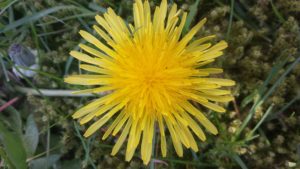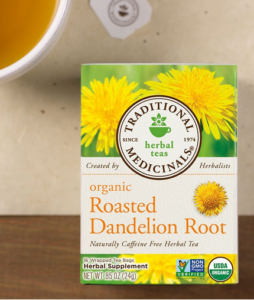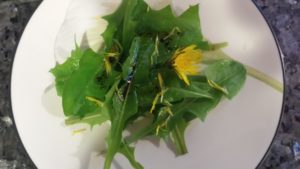Happy Spring! For those of you who live in the Pacific Northwest, you undoubtedly have noticed the greening of your world – the buds on the trees, the sunny yellow of forsythia bushes and daffodils, and the rows of bright-colored flowers at nurseries and grocers. If you are a gardener-not-yet-turned-herbalist, you might also have begun cursing the dandelion leaves on the edges of flower beds or poking out of inhospitable cracks in the sidewalk. Before you declare war (and heaven forbid, chemical warfare) on this “weed”, I’d like to do a quick Public Service Announcement on dandelion’s behalf.

It is not an overstatement to say that the dandelion is revered by herbalists. One of my favorite herb sites uses it as their logo. The best herb shop in Seattle is named after it (Dandelion Botanical). But why all the love for the oft-hated-on dandelion (Taraxacum officinale)? Its Latin name gives a clue. “Officinal-” is the species name. It denotes that the plant has been used as a remedy at least since the Middle Ages when it was cultivated in the medicinal herb gardens of monks. That’s right. Wise people actually grew the dandelion on purpose.
What makes the dandelion so special? Basically, every part of the dandelion can be used safely as food or medicine. Say whaaaat?
Roots: Dandelion roots are excellent at clearing Heat (conditions that are red, hot, inflamed) and toxins. They have an affinity for the liver and are used to treat hepatitis, jaundice and cirrhosis. They are also effective for “hot” skin conditions like rashes, chicken pox, eczema, and poison oak and ivy. They also aid digestion and elimination, help to dissolve gallbladder and kidney stones and regulate blood sugar. Scientists also are now confirming their anti-cancer properties.

The roots are commonly prepared as a coffee substitute, like chicory. Note: Roasting the root makes it milder and sweeter. If you make tea from a freshly-harvested root, it will be much more bitter. That’s good for your digestion and liver, but can be an initial shock to your taste buds.
Stem: These babies are versatile. In the last two weeks, I’ve seen an herbal post for a fermented dandelion stem recipe and a video showing you how to use a tall stem as a horn. (Toot!) The sap also can be used to reduce warts and treat snakebites!
Leaves: In Europe, young leaves are known as a “spring tonic” and used in salads (or you could just pick and eat them straight out of the yard like my hubbie). After a long winter of heavy, starchy foods, the leaves are also a great liver cleanse. Both the leaves and the roots contain Vitamins A, B, C, and E, as well as the minerals iron, phosphorus, potassium and calcium. Dandelion leaf tea (drank cool) is an extremely effective diuretic, eliminating the retention of water and lowering blood pressure.
My favorite way to eat dandelion leaves is as a pesto. (Recipe below!)

Flowers: When the flowers are fully open, they are excellent edibles that can be dipped and sautéed into fritters (great with stone-ground mustard). The petals also make a sunny addition to honey-sweetened oat cookies. This year I’m trying dandelion jelly. Perhaps the tastiest way our forebearers used the flowers? Dandelion wine!

This spring, instead of angrily denouncing their persistence and spraying them with weed-kill (for shame!), harvest dandelions for their many benefits. Still not a believer? Try this delicious recipe adapted from Rosalee de la Forêt.
Important notes: It should go without saying, but never eat dandelions that have been sprayed or that grow in polluted areas (including ones frequented by four-leggeds)! Dandelions have some look-alikes so make sure you have the right plant. Only the dandelions with smooth (not hairy) leaves should be used.
Dandelion Pesto Recipe
- 2 cups tightly-packed dandelion leaves (fresh and tender, well-rinsed)
- 3/4 cup olive oil
- 1/2 cup Parmesan cheese (may be omitted)
- 3 cloves garlic
- 1/2 cup chopped walnuts (cheaper than pine nuts and really good for you! they taste even better when toasted)
- Juice from 1/2 a lemon
- Lemon zest (optional)
- Paprika (optional)
Place all ingredients in blender or food processor and blend until smooth. Store in the refrigerator and eat within a few days. You can also freeze it. It is good as a dip, on pasta, paninis and even on eggs!
